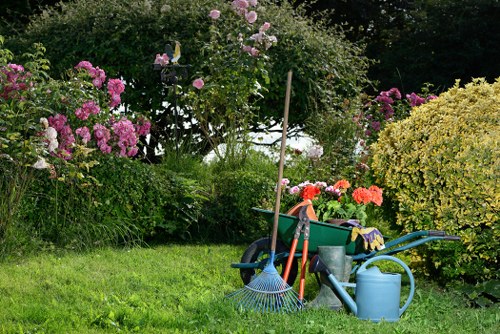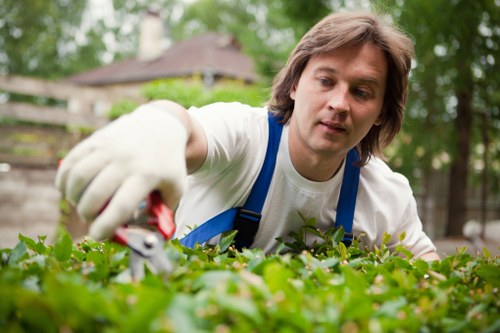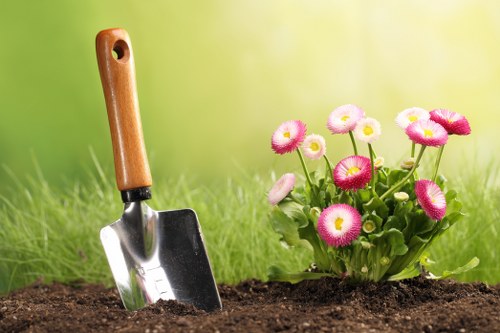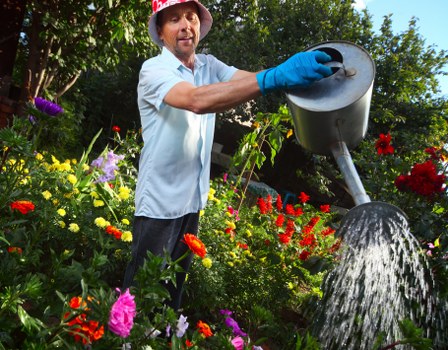The Ultimate Guide to Jet Washing Temples: Techniques and Best Practices

Jet washing is an essential maintenance practice for preserving the beauty and integrity of temples. These sacred structures, often built with intricate designs and materials that require careful upkeep, benefit greatly from professional cleaning methods. In this guide, we will explore the various aspects of jet washing temples, including techniques, benefits, and best practices.
Maintaining a temple's exterior not only enhances its aesthetic appeal but also ensures the longevity of its construction. Over time, temples can accumulate dirt, moss, algae, and other contaminants that can cause deterioration if left untreated. Jet washing provides an effective solution to remove these impurities without causing damage to the delicate surfaces.
Understanding the specific requirements of temple structures is crucial when planning a jet washing project. Different materials, such as stone, brick, wood, and metal, respond differently to high-pressure cleaning. Selecting the appropriate pressure level and cleaning agents is essential to preserve the temple's architectural features and historical significance.

There are several jet washing techniques that can be utilized based on the temple's construction and the type of contaminants present. Soft washing, for instance, uses lower pressure combined with specialized cleaning solutions, making it ideal for delicate surfaces that cannot withstand high-pressure sprays.
On the other hand, power washing employs higher pressure and is suitable for removing more stubborn grime and buildup from robust materials like stone and concrete. It is important to assess the surface before choosing the appropriate method to avoid any unintended damage.
Safety is a paramount concern during the jet washing process. Temple structures often feature intricate carvings and delicate fixtures that require careful handling. Using protective equipment and following safety protocols helps in maintaining the integrity of these sacred spaces while ensuring the safety of the cleaning crew.

One of the main benefits of jet washing temples is the prevention of long-term damage. Regular cleaning helps to eliminate elements that can degrade materials, such as moisture, which can lead to mold growth and erosion. By removing these harmful substances, jet washing contributes to the preservation of the temple for future generations.
Another advantage is the enhancement of the temple's visual appeal. A clean temple attracts more visitors and fosters a sense of pride within the community. It also reflects the care and dedication of those responsible for its upkeep, reinforcing the temple's role as a spiritual and cultural landmark.
Environmental considerations are also important when jet washing temples. Using eco-friendly cleaning agents and techniques minimizes the impact on surrounding flora and fauna. Additionally, proper water management ensures that runoff does not contaminate nearby water sources or disrupt the local ecosystem.

Planning a jet washing project involves several key steps. First, conduct a thorough inspection of the temple to identify areas that require cleaning and to assess the condition of the surfaces. This evaluation helps in determining the most effective cleaning method and in estimating the time and resources needed.
Next, select the appropriate equipment and cleaning solutions based on the inspection findings. It is advisable to consult with professionals who have experience in cleaning similar structures to ensure that the chosen approach is both effective and safe.
Once the preparation is complete, schedule the jet washing process at a time that minimizes disruption to the temple's activities and respects its sacred nature. Ensuring clear communication with all stakeholders helps in coordinating efforts and achieving the best possible results.

After the cleaning process, it is essential to perform a post-wash inspection to ensure that all areas have been adequately treated and to identify any areas that may need additional attention. Regular maintenance schedules should be established to keep the temple in optimal condition and to address any issues promptly.
In conclusion, jet washing is a vital practice for maintaining the beauty and structural integrity of temples. By employing the right techniques and adhering to best practices, temple caretakers can ensure that these sacred places remain pristine and welcoming for generations to come.
Investing in professional jet washing services not only safeguards the temple's physical condition but also supports the preservation of cultural and spiritual heritage. Embracing this proactive approach is a testament to the community's commitment to honoring and protecting its cherished landmarks.
Benefits of Jet Washing Temples

Enhanced Aesthetic Appeal: Jet washing removes dirt, grime, and biological growth, restoring the temple's original beauty.
Structural Preservation: Regular cleaning prevents material degradation and prolongs the lifespan of temple structures.
Health and Safety: Eliminating mold, algae, and moss reduces health risks for visitors and maintains a safe environment.

Cost-Effective Maintenance: Preventative cleaning reduces the need for expensive repairs caused by neglect.
Environmental Sustainability: Using eco-friendly cleaning agents protects the surrounding ecosystem.
Community Pride: A well-maintained temple fosters a sense of pride and respect within the community.
Jet Washing Techniques for Different Materials

Soft Washing for Delicate Surfaces
Soft washing is ideal for materials that cannot withstand high pressure. This method uses lower pressure combined with specialized cleaning solutions to gently remove contaminants.
Power Washing for Sturdy Structures
Power washing employs higher pressure to effectively remove stubborn grime from robust materials like stone and brick.
Hand Washing for Intricate Areas
Some areas with intricate carvings or delicate fixtures require hand washing to prevent damage and ensure thorough cleaning.

Using Eco-Friendly Cleaning Solutions
Eco-friendly solutions minimize environmental impact and ensure the safety of both the temple and surrounding areas.
Proper Equipment Selection
Selecting the right equipment based on the surface material and type of contaminants is crucial for effective and safe cleaning.
Safety Protocols
Adhering to safety protocols protects both the cleaning crew and the structural integrity of the temple.
Local Relevance: Nearby Areas to Jet Wash Temples

Understanding the local context is vital for jet washing projects. Here are some nearby areas that are significant for keeping temples clean:
- Central Temple Park: Located 2 miles from the main temple, this area often hosts community events requiring regular cleaning.
- Eastside Courtyard: Just 1 mile away, the courtyard features historical statues that benefit from gentle jet washing.
- West Gate Plaza: 3 miles from the temple, this plaza attracts many visitors, necessitating frequent maintenance.
- North Garden Path: At 1.5 miles distance, the garden path requires eco-friendly cleaning solutions to protect plant life.
- South Entrance Drive: 2.2 miles from the temple, the drive area sees heavy traffic and needs robust jet washing techniques.
- Lakeside Pavilion: 4 miles away, the pavilion's stone structures are ideal candidates for power washing.
- Old Market Square: 3.5 miles from the temple, this commercial area benefits from regular cleaning to maintain its appeal.
- Heritage Museum: Located 2.8 miles away, the museum's exterior surfaces are preserved through soft washing.
- Riverside Walk: 3 miles distance, the walk area requires hand washing for its delicate carvings.
- Hilltop Sanctuary: 5 miles from the temple, this sanctuary's remote location necessitates careful planning for jet washing services.
- Community Library: 1.8 miles away, the library's facade is regularly maintained to reflect its importance.
- Sunset Boulevard: 2.5 miles from the temple, the boulevard area involves extensive cleaning to handle high visitor numbers.
- Maple Street Market: 3.2 miles away, the market's vibrant surroundings require frequent and thorough jet washing.
- Crystal Fountain: 4.5 miles from the temple, the fountain area benefits from eco-friendly cleaning to preserve water quality.
- Elmwood Plaza: 2.7 miles distance, this plaza often hosts events that necessitate immediate cleaning post-usage.
Choosing the Right Jet Washing Service
Selecting a professional jet washing service ensures the temple is cleaned effectively and safely. Consider the following factors:
- Experience: Look for companies with a proven track record in cleaning historical or delicate structures.
- Equipment: Ensure the service provider uses the appropriate equipment for different surfaces.
- Eco-Friendly Practices: Choose services that prioritize environmental sustainability.
- References: Check reviews and ask for references to gauge the quality of work.
- Insurance: Verify that the company is insured to protect against any potential damages.
Additionally, clear communication regarding expectations, timelines, and pricing is essential. A reputable service provider will offer a detailed plan and be transparent about their processes.
Scheduling regular maintenance helps in keeping the temple in optimal condition. Establishing a maintenance calendar with periodic jet washing sessions prevents the accumulation of damaging contaminants.
Investing in quality services not only maintains the temple's appearance but also upholds its historical and spiritual significance.
Best Practices for Jet Washing Temples
Adhering to best practices ensures that jet washing is performed effectively and safely:
- Surface Assessment: Evaluate each surface to determine the appropriate cleaning method.
- Testing: Conduct a small test area before full-scale washing to ensure no damage will occur.
- Proper Equipment Use: Utilize the correct pressure settings and nozzles for different materials.
- Protective Measures: Cover sensitive areas and use barriers to protect surrounding vegetation.
- Post-Cleaning Inspection: Review the cleaned areas to ensure thoroughness and address any missed spots.
Maintaining safety standards is crucial. Ensure that all personnel are trained in jet washing techniques and aware of the temple's layout to prevent accidents.
Using biodegradable and non-toxic cleaning agents preserves the environment and safeguards the health of visitors and staff.
Documentation of the cleaning process helps in monitoring the temple's condition and planning future maintenance effectively.
Challenges and Solutions in Jet Washing Temples
Jet washing temples can present unique challenges due to their age, materials, and intricate designs:
- Delicate Structures: Some temples have fragile components that require gentle cleaning methods.
- Accessibility: High or hard-to-reach areas may need specialized equipment or techniques.
- Environmental Restrictions: Certain areas may have regulations to protect local ecosystems during cleaning.
- Preservation of Artifacts: Cleaning near sensitive artifacts requires careful planning to avoid damage.
- Weather Conditions: Adverse weather can delay cleaning schedules and affect the effectiveness of jet washing.
Solutions to these challenges include:
- Collaborating with conservation experts to determine the best cleaning practices.
- Using scaffolding or aerial lifts to access difficult areas safely.
- Scheduling cleaning during favorable weather and off-peak seasons.
- Implementing strict safety and preservation protocols to protect both the temple and its artifacts.
- Utilizing advanced technology to enhance cleaning precision and efficiency.
By addressing these challenges proactively, jet washing projects can be executed smoothly and successfully.
Case Studies: Successful Jet Washing Projects
Examining successful jet washing projects can provide valuable insights and best practices:
Temple of Harmony
The Temple of Harmony underwent a comprehensive jet washing project that used soft washing techniques to preserve its intricate stone carvings. The project resulted in a significant enhancement of the temple's appearance without causing any damage.
Sunrise Sanctuary
Located near the Riverside Walk, Sunrise Sanctuary faced challenges with algae growth on its exterior walls. A power washing approach effectively removed the buildup, restoring the temple's pristine look and preventing future growth.
Evergreen Temple
Evergreen Temple, situated close to the Hilltop Sanctuary, required delicate cleaning of its wooden fixtures. Hand washing methods ensured that the wooden elements were preserved while achieving thorough cleanliness.
These case studies highlight the importance of tailored approaches and the benefits of professional jet washing services in maintaining the integrity and beauty of temple structures.
In each instance, the careful selection of techniques and adherence to best practices ensured successful outcomes, demonstrating the effectiveness of jet washing in preserving sacred spaces.
Drawing from these examples can help guide future projects and promote the continued preservation of temples through effective cleaning strategies.
Frequently Asked Questions
1. What is jet washing?
Jet washing, also known as pressure washing, is a cleaning method that uses high-pressure water spray to remove dirt, grime, moss, and other contaminants from surfaces.
2. Is jet washing safe for all temple materials?
No, jet washing must be tailored to the specific materials of the temple. Delicate surfaces like wood or intricate stone carvings require softer washing techniques, while sturdier materials like concrete and brick can withstand higher pressures.
3. How often should a temple be jet washed?
The frequency of jet washing depends on the temple's location, environmental conditions, and the materials used in its construction. Generally, an annual or bi-annual cleaning schedule is recommended to maintain the temple's appearance and integrity.
4. What are the benefits of using eco-friendly cleaning agents?
Eco-friendly cleaning agents minimize environmental impact, protect surrounding flora and fauna, and ensure the safety of visitors and staff by avoiding harmful chemicals.
5. Can jet washing help preserve a temple's historical features?
Yes, when performed correctly, jet washing can remove damaging contaminants and prevent material degradation, thereby preserving the temple's historical and architectural features for future generations.


